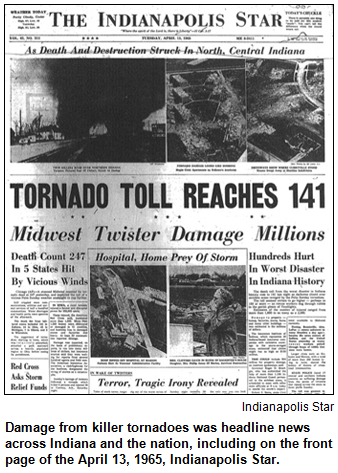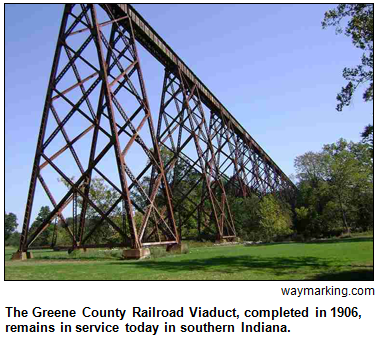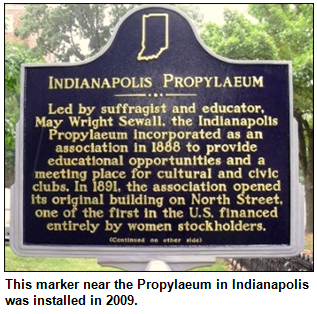You can listen to Hoosier History Live! live on the air each Saturday, or listen online at the WICR website during the broadcast on any computer with speakers, anywhere, or on a smartphone. We invite you to visit our website!
March 24 show
Palm Sunday tornado outbreak of 1965
 "The day started out warm and sunny, but became increasingly hot and humid, not at all like a typical day in April," Dennis Keyser recalls.
"The day started out warm and sunny, but became increasingly hot and humid, not at all like a typical day in April," Dennis Keyser recalls.
The hot, humid weather on Palm Sunday was particularly atypical in far-northern Indiana. That's where 10-year-old Dennis, a native of Bremen, lived with his family in 1965.
His boyhood experiences on April 11, 1965, changed his life - and set Dennis on his career path. Today, after studying atmospheric sciences at Purdue University and then earning a master's in meteorology with a focus on severe weather dynamics and forecasting, he lives in Silver Spring, Md., and works in a highly specialized field of troubleshooting and formatting related to weather data from satellites, radar and aircraft.
He was a passenger in his family's car on Palm Sunday 1965 when the hot, humid weather suddenly became eerie.
"As we approached LaPorte, we noticed the sky to the south and west began to take on a green color. I had never seen this before," he recalls.
After a harrowing car ride - during which a radio announcer proclaimed - "“Bulletin: Tornado west of Bremen!" - Dennis and his family made it home. En route, he witnessed a portion of the tragic impact of the Palm Sunday tornado outbreak.
 "I could not sleep that night," Dennis recalls. "Ambulances were coming into Bremen Hospital one block from my house all night long."
"I could not sleep that night," Dennis recalls. "Ambulances were coming into Bremen Hospital one block from my house all night long."
Devastating tornadoes struck northern Indiana communities, including Goshen, LaPaz, Lakeville and Wyatt (the first F-4 tornado alone, whose aftermath Dennis witnessed from the family car, killed 10 people and injured 180) as well as Dunlap, a small community between Goshen and Elkhart that was hit by two separate tornadoes - a rare "double funnel."
Dennis will be Nelson's guest to share insights about the tragic tornado outbreak on Palm Sunday of 1965, which became an unforgettable day for so many Hoosiers.
In total, the twisters killed 137 Hoosiers and injured about 1,200 others. According to several sources, 10 tornadoes swept through the state that day.
Much of Russiaville in Howard County was destroyed; in nearby Kokomo, a tornado that was 800 yards wide killed 25 people. Tornadoes also swept through Marion, Greentown, Berne and Sheridan.
"The ironic thing is that due to the heavy rain I never actually saw the tornado, even though we were not that far behind it to the north and west," Dennis recalls, referring to his family's terrifying car ride.  "In any event, all evening long we watched the South Bend news on TV. We heard about the other devastating tornadoes nearby."
"In any event, all evening long we watched the South Bend news on TV. We heard about the other devastating tornadoes nearby."
Sadly, this Hoosier history topic is timely because of the tragic tornado outbreak that ravaged far-southeastern Indiana earlier this month.
Six counties were hit hard by the March 2 tornadoes, which killed 13 Hoosiers and destroyed hundreds of homes and businesses. In Clark County, the towns of Marysville and Henryville have suffered horrific damage.
With the Palm Sunday tornadoes in 1965 - which affected six Midwestern states and are generally considered the worst outbreak in American history until that time - forecasts and watches about the severe weather were regarded as good.
However, subsequent research indicated many people did not receive the warnings because they were outdoors in the unseasonably balmy weather. And when telephone and electrical lines collapsed, people could not receive warnings about the ferocious tornadoes during an era before cell phones and the Internet.
Even three days after the tragic Palm Sunday tornado outbreak, our guest Dennis had an unforgettable experience: He saw his first U.S. president. Dennis' dad took him to South Bend to witness the arrival of Lyndon Johnson, who toured the devastation in northern Indiana.
 As a meteorologist now, Dennis works for the National Centers for Environmental Protection's Environmental Modeling Center in Camp Springs, Md. He also recommends this blog, which features reports by eyewitnesses to the Palm Sunday storms.
As a meteorologist now, Dennis works for the National Centers for Environmental Protection's Environmental Modeling Center in Camp Springs, Md. He also recommends this blog, which features reports by eyewitnesses to the Palm Sunday storms.
The tornadoes roared through Indiana in the late afternoon and evening. To this day, sources disagree about the precise location of the infamous "double-funnel tornado" that swept through residential areas near Elkhart and Dunlap.
Regardless, the tornado outbreaks destroyed several trailer parks and lakeside communities. In the Hoosier state, the first tornado touched down at 5:30 pm at Koontz Lake in far-northern Indiana. The outbreak eventually included a ferocious F-5 tornado (near Elkhart) with winds of between 261 and 318 mph.
History Mystery
Bremen is the hometown of Otis Bowen, a physician who became a popular governor of Indiana for two terms, beginning in 1972. One of Gov. Bowen's sons, Rob Bowen, also attempted a political career. In 1986, he campaigned to be Indiana's secretary of state, but he lost the election to a young attorney from another family well-known in Hoosier politics.
Question: Who defeated Rob Bowen in the 1986 election?
To win the prize, you must call in with the correct answer during the live show and be willing to be placed on the air. Please do not call if you have won a prize from any WICR show during the last two months. The call-in number is (317) 788-3314, and please do not call until you hear Nelson pose the question on the air.
This week's prize is one night at the Courtyard by Marriott in downtown Indianapolis, as well as two tickets to the NCAA Hall of Champions, courtesy of the ICVA.
Roadtrip: Greene County Railroad Viaduct
 Roadtripper Chris Gahl of the ICVA suggests that we head southeast from Indianapolis to see a structure that is the third-largest of its kind in the world, the Greene County Railroad Viaduct, also known as the Tulip Trustle.
Roadtripper Chris Gahl of the ICVA suggests that we head southeast from Indianapolis to see a structure that is the third-largest of its kind in the world, the Greene County Railroad Viaduct, also known as the Tulip Trustle.
The viaduct was completed in 1906 when the Illinois Central tracks were extended from Indianapolis to Effingham, Ill. The steel and concrete structure is supported by 18 towers, is 2,295 feet (nearly half a mile) long, and 180 feet high, and it spans Richland Creek. Other than two 45-foot sections that were added in 1916, the bridge is much as it was when it was built.
Here are directions (yes, it is a backroads adventure); it's about 22 miles southwest of Bloomington. It still carries rail traffic, although, sadly, it appears to be a hot spot for graffiti.
This Roadtrip was suggested by Margaret Smith, who was a guest on the Oct. 22, 2011 Hoosier History Live! show when she talked about Indiana's covered bridges, along with Larry South of Rush County.
Your Hoosier History Live! team,
Nelson Price, host and creative director
Molly Head, producer, (317) 927-9101
Chris Gahl, Roadtripper
Richard Sullivan, webmaster and tech director
Pam Fraizer, graphic designer
Garry Chilluffo, creative consultant
Michele Goodrich, Jed Duvall, grant consultants
Joan Hostetler, photo historian
Dana Waddell, volunteer-at-large
www.hoosierhistorylive.org





Please tell our sponsors that you appreciate their support: Aesop's Tables, Indiana Historical Society, Indiana Authors Award, Lucas Oil and Story Inn.
 Acknowledgments to Print Resources, Indianapolis Marion County Public Library, Monomedia, Indiana Humanities, Indianapolis Convention & Visitors Association, WICR-FM, Fraizer Designs, Heritage Photo and Research Services, Derrick Lowhorn, Samantha Stratton and many other individuals and organizations. We are an independently produced program and are self-supporting through organizational sponsorships, grants and through individual tax-deductible contributions through the Indiana Humanities Council. Visit our website to learn how you can support us financially.
Acknowledgments to Print Resources, Indianapolis Marion County Public Library, Monomedia, Indiana Humanities, Indianapolis Convention & Visitors Association, WICR-FM, Fraizer Designs, Heritage Photo and Research Services, Derrick Lowhorn, Samantha Stratton and many other individuals and organizations. We are an independently produced program and are self-supporting through organizational sponsorships, grants and through individual tax-deductible contributions through the Indiana Humanities Council. Visit our website to learn how you can support us financially.
March 31 show
Indiana's remarkable suffragist
Among the distinguished Hoosiers honored with the first 10 pillars unveiled earlier this month along Georgia Street in downtown Indy, many of the notables remain household names. They include Madam Walker, Tecumseh and Abraham Lincoln, who spent his youth in Indiana.
 Who, though, was May Wright Sewall?
Who, though, was May Wright Sewall?
The dedication of her pillar - and Women's History Month - are ideal opportunities to explore the colorful life of this once nationally famous leader of the women's suffrage movement who also had a huge impact on her adopted hometown in the arts, culture and education.
Among an array of accomplishments, some of which were regarded as radical during her heyday, May Wright Sewall (1844-1920) launched a private school that revolutionized the education of girls in the Hoosier capital. She also became known as the leader of "half a million women" because of her influential work to organize women across the country - and even overseas, after trips to the Netherlands and other European countries.
Sadly, although Mrs. Sewall worked tirelessly for voting rights for women all of her life, she never got to cast a ballot in a presidential election. Her death in 1920 came just months before U.S. women got to vote for president for the first time.
To explore the life of this remarkable civic leader, who helped start groups that evolved into the Indianapolis Museum of Art as well as an into an array of various non-profits that continue to this day, Nelson will be joined in studio by two experts.
They are Ray Boomhower, author of But I Do Clamor: May Wright Sewall, A Life, and Jan Wahls, past president of the Indianapolis Propylaeum Club, which was founded by Mrs. Sewall during an era when a club both for women and managed by women was considered radical.
Jan, who often portrays Mrs. Sewall as a re-enactor in vintage costume, also is a member of the Contemporary Club, yet another civic organization founded by May that continues to this day.
 Consider this: When Mrs. Sewall launched the Indianapolis Classical School for Girls in the1880s, she shocked Hoosiers by insisting on a gymnasium. (In that era, physical education was almost unheard of for girls and women - who should not be seen sweating, according to prevailing social attitudes.)
Consider this: When Mrs. Sewall launched the Indianapolis Classical School for Girls in the1880s, she shocked Hoosiers by insisting on a gymnasium. (In that era, physical education was almost unheard of for girls and women - who should not be seen sweating, according to prevailing social attitudes.)
Also at Mrs. Sewall's insistence, her students were taught Latin, Greek and world literature as part of a curriculum just as rigorous as that offered at a school for boys founded by her husband. Before Mrs. Sewall, education for most girls in Indy ended after some instruction in running a home.
"She served as an invaluable ally to such national suffrage leaders as Susan B. Anthony and Elizabeth Cady Stanton, and (she) gave the women's movement an international focus," Ray Boomhower writes in his biography.
It's one of several books about notable Hoosiers written by Ray, who also is editor of Traces of Indiana and Midwestern History, the popular magazine published by the Indiana Historical Society.
A final tidbit about May Wright Sewall: She also shocked the city by wearing her skirts at ankle length. In the 1890s, most women's skirts swept the ground. Historians say only a woman as highly regarded and as forceful as Mrs. Sewall could have gotten away with such a breach of etiquette.
© 2012 Hoosier History Live! All rights reserved.